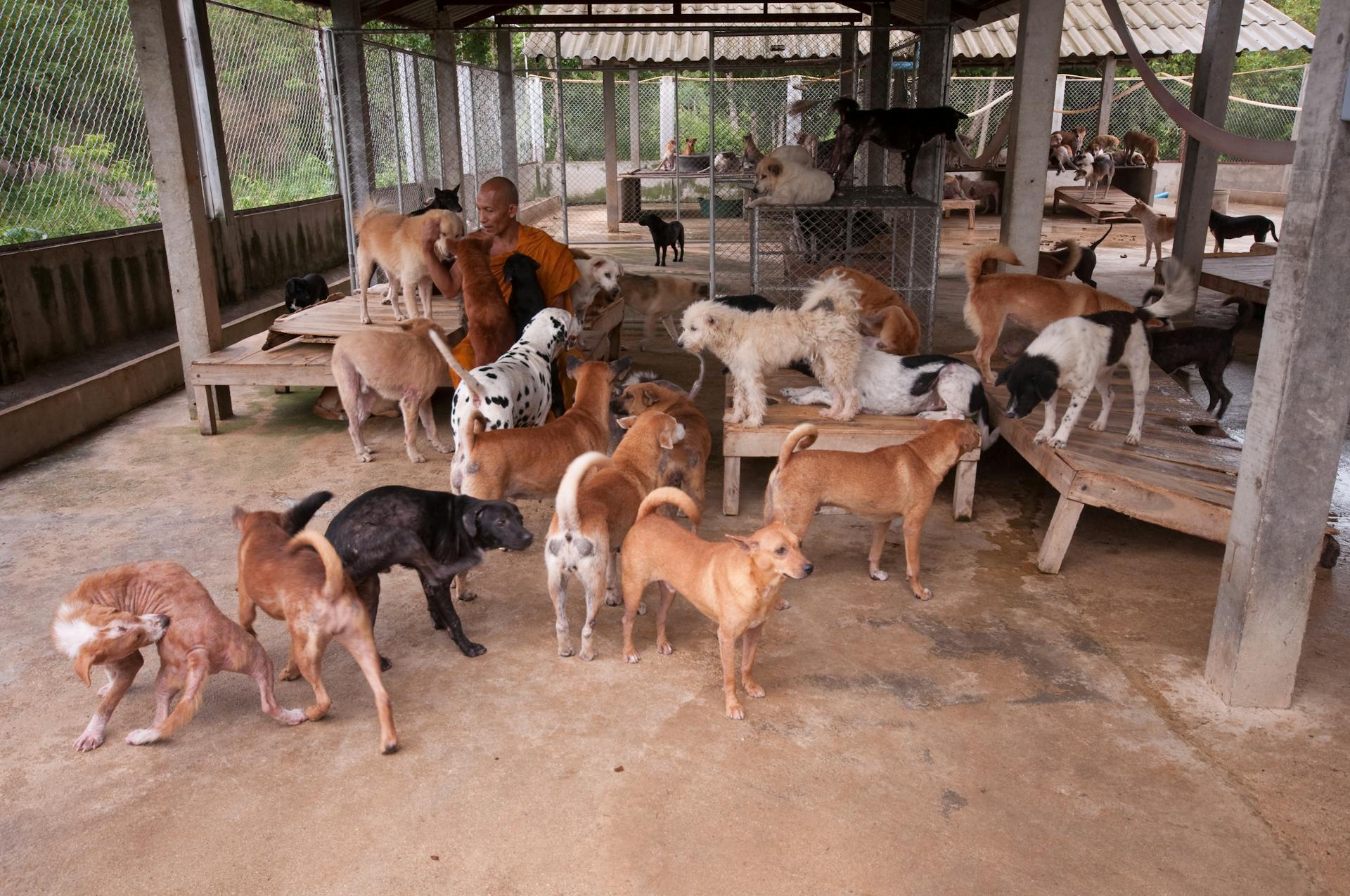
The world of dogs is a vast and wonderful place, with over 340 recognized breeds to choose from. This number is constantly evolving as new breeds are developed and old ones are recognized.
The Fédération Cynologique Internationale (FCI), also known as the World Canine Organization, is responsible for maintaining the official register of purebred dogs. They recognize 340 breeds from around the world.
The American Kennel Club (AKC) also recognizes over 200 breeds, although their list may not be entirely identical to the FCI's. This discrepancy highlights the complexity of categorizing dog breeds.
Expand your knowledge: Show Me the Biggest Dog in the World
What is a Dog Breed?
Dog breeds are a specific set of heritable characteristics determined by kennel clubs that recognize the breed. This is in contrast to dog types, which are broader categories based on form, function, or style of work.
A study in 2010 looked at 48,000 single nucleotide polymorphisms in 912 dogs representing 85 breeds. It found distinct genetic clusters within modern dogs that largely corresponded to phenotype or function.
Dog types can be thought of as categories that group dogs by their physical characteristics, work style, or lineage. These categories include spitz-breeds, toy dogs, spaniels, Mastiff-like breeds, and many others.
The study mentioned earlier found 17 breeds that conflicted with phenotype or function, suggesting they were the result of crossing some of the other phenotypes. These breeds were likely created through controlled breeding practices during the Victorian era.
Here are some examples of dog types mentioned in historical texts:
- Greyhound, bastard, mongrel, mastiff, limer, spaniel, and raches (small-to-medium-sized scenthounds)
- Kennets (small hunting dogs), terriers, "butcher's hounds", dung-heap dogs, and prick-eared curs
- Small ladies puppies that bear away the fleas and diverse small sorts
The study also found three well-supported groups that were highly divergent and distinct from modern domestic dogs. These groups included an Asian group, a Middle Eastern group, and a northern group.
Consider reading: Terrier Group
Dog Classification and Evolution
Dog classification can be a bit confusing, but it's actually quite fascinating. The American Kennel Club (AKC) classifies dog breeds into seven groups, which include Sporting, Hound, Working, Terrier, Toy, Non-Sporting, and Herding.
The AKC's classification system has undergone changes over the years. In the 1800s, they started with just two groups: Sporting and Non-Sporting. They've since split these groups into more specific categories, with the last major change happening in 1984 when Herding dogs were separated from the Working group.
Expand your knowledge: Working Dogs Breeds
There are over 340 recognized dog breeds globally, with each breed having its unique characteristics and purposes. Dogs were primarily bred for tasks like hunting, herding, and guarding, which has led to the incredible diversity of breeds we see today.
A study in 2010 looked at 48,000 single nucleotide polymorphisms in 912 dogs representing 85 breeds. The study found distinct genetic clusters within modern dogs, largely corresponding to phenotype or function. These clusters included spitz-breeds, toy dogs, spaniels, Mastiff-like breeds, small terriers, retrievers, herding dogs, scent-hounds, and sight-hounds.
Here are some examples of dog breeds that fit into each of these clusters:
- Spitz-breeds: Chow Chow, Akita, Alaskan Malamute
- Toy dogs: Poodle, Chihuahua, Yorkshire Terrier
- Spaniels: Cocker Spaniel, Springer Spaniel
- Mastiff-like breeds: Bulldog, Pug, Mastiff
- Small terriers: Cairn Terrier, West Highland White Terrier
- Retrievers: Golden Retriever, Labrador Retriever
- Herding dogs: German Shepherd, Border Collie
- Scent-hounds: Beagle, Bloodhound
- Sight-hounds: Greyhound, Whippet
The domestic dog is the first species to have been domesticated, and they've undergone rapid phenotypic change over the past 200 years. This has led to the incredible diversity of breeds we see today, with dogs varying in size and weight from the 0.46 kg (1.0 lb) teacup poodle to the 90 kg (200 lb) giant mastiff.
If this caught your attention, see: Pinscher 0
Dog Types and Categories
There are over 340 types of dog breeds recognized globally, with various kennel clubs classifying them differently. The American Kennel Club (AKC) classifies breeds into seven groups, including Sporting, Hound, Working, Terriers, Toy, Non-sporting, and Herding.
The AKC's classification system has undergone changes over time, with the most recent split occurring in 1984 when the Herding group was separated from the Working group. The AKC currently recognizes 201 breeds with full recognition.
Dog breeds can also be categorized into seven major groups based on their sizes and the reasons they were bred for. These groups include Working, Herding, Hound, Sporting, Non-Sporting, Toy, and Terrier.
Here's a breakdown of the seven major groups:
These categories help to understand the diversity of dog breeds and how they were developed for specific purposes.
Dog Types and Categories
Dog types and categories can be a bit confusing, but essentially, they refer to broad groups of dogs based on their form, function, or original purpose.
There are several kennel clubs that classify dog breeds into different groups, with the American Kennel Club (AKC) being one of the most well-known. The AKC classifies breeds into seven groups: Sporting, Hound, Working, Terrier, Toy, Non-Sporting, and Herding.
Other kennel clubs, like the UKC and Kennel Club, use different groupings, with the UKC dividing breeds into Guardians, Scent hounds, Sight hounds, and Pariah dogs, among others. The Kennel Club divides breeds into Hound, Working, Terrier, Gun dog, Pastoral, Utility, and Toy groups.
There are over 340 recognized dog breeds globally, with different breeds being recognized by various kennel clubs. The Fédération Cynologique Internationale (FCI) recognizes 356 purebreds, while the AKC registers 201 breeds and the FCI lists 360 breeds.
Dog breeds can be categorized into 7 major groups based on their sizes and original purposes. These groups include Working, Herding, Hound, Sporting, Non-Sporting, Toy, and Terrier.
Here's a breakdown of the different types of dog breeds:
These categories can be helpful in understanding the different types of dog breeds and their original purposes. However, it's worth noting that different kennel clubs may have different classifications, and some breeds may not fit neatly into one category.
A different take: Different Types of Shih Tzu Breeds
Sheepdogs and Cattle
Sheepdogs and herding dogs, with the exception of the Swiss Mountain Dog, are part of Group 1 and cover 44 breeds.
These dogs are highly skilled at herding and working with livestock, often requiring strong instincts and intelligence.
Readers also liked: Australian Shepherd Herding Dog Breeds
Recognized Dog Registries
There are several major kennel clubs that recognize dog breeds, including The Kennel Club, American Kennel Club, and United Kennel Club, to name a few.
These registries classify recognized dog breeds into groups such as Hound, Terrier, Working, Herding, Sporting, Non-Sporting, Toy, and Miscellaneous.
The Fédération Cynologique Internationale (FCI) is a global canine organization that ensures each of its member and contract partners mutually recognizes the pedigrees and judges of all FCI members.
The AKC, FCI, and KC are the three major registries that Good Dog recognizes as purebred if they are recognized by any of these organizations.
Here's a list of some of the major registries mentioned in the article:
- The Kennel Club (1873, UK)
- American Kennel Club (1884)
- New Zealand Kennel Club (1886)
- Canadian Kennel Club (1888)
- United Kennel Club (1898)
- United Kennel Clubs International (UCI, Germany 1976)
- Australian National Kennel Council (1958)
Becoming a Recognized Breed
The AKC has very clear requirements for breeds looking to join its ranks, and these requirements have become more stringent over time.
In the past, breeds had to belong to the Sporting group, but today they can be part of any of the recognized groups. The first breeds recognized by the AKC in 1878 were the Chesapeake Bay retriever, Clumber spaniel, cocker spaniel, English setter, Gordon setter, Irish setter, Irish water spaniel, pointer, and Sussex spaniel.
Getting AKC recognition is not easy, and it's not just a matter of breeding dogs with desirable traits. In fact, all major registries explicitly state that a new breed cannot be the result of a direct cross between two already recognized breeds.
Today, the AKC has welcomed 23 new breeds in the past 10 years, and the club recently welcomed its 201st breed, the Lancashire heeler. Even with these new additions, the AKC remains a highly selective organization.
The AKC has a long history of recognizing new breeds, from the early days of the club to the present. The first breed recognized by the AKC was the Chesapeake Bay retriever, and since then, many other breeds have been added to the roster.
To become a recognized breed, a dog must meet the AKC's strict criteria, which include a unique set of characteristics, a defined breed standard, and a strong breed club.
Major Registries
The world of dog registries can be overwhelming, especially when you consider the sheer number of breeds out there. There are over 100 national kennel clubs around the world, each with their own set of recognized breeds.
Some of the major registries include The Kennel Club (1873, UK), American Kennel Club (1884), and United Kennel Club (1898). These registries have been around for a long time and are well-established in the dog breeding community.
The Fédération Cynologique Internationale (FCI) is a global canine organization that's neither a breed registry nor does it issue pedigrees. Instead, it acts as a governing body that ensures member countries mutually recognize each other's pedigrees and judges.
Take a look at this: Tibetan Mastiff Biggest Dog in the World
Here are some of the major registries and their founding years:
The way breeds are classified can vary between registries, but most use a system of groups to categorize them.
Mixed
Mixed breeds are often misunderstood, but they're not necessarily a mix of defined breeds. In fact, they can be the result of random-bred populations that haven't been intentionally bred for specific characteristics.
The term "mongrel" is sometimes used to describe mixed breeds, but it can have negative connotations, so many people prefer to use "mixed-breed" instead.
In the United States, "mixed-breed" is a more widely accepted term, especially among dog owners who want to emphasize that their pets are unique and valuable in their own right.
Purebred dogs, on the other hand, have been artificially created through selective breeding to enhance specific traits, which means that mixed breeds aren't necessarily a mix of these defined breeds.
Expand your knowledge: Field Bred English Cocker Spaniel
Lists and Information
The Fédération Cynologique Internationale recognizes 356 purebred dog breeds, but there's still debate about the actual number of breeds. The AKC lists 201 breeds with full recognition, while the FCI lists 360 breeds. The United Kennel Club (UKC) recognizes 376 breeds, and the Kennel Club in Britain recognizes 222 breeds.
There are over 100 national kennel clubs around the world, each with their own recognized breeds. For example, the Indian National Kennel Club recognizes the Mudhol hound, while the Vietnam Kennel Association recognizes the Phu Quoc ridgeback. Each kennel club has its own classification system, with some grouping breeds into categories like Sporting, Hound, and Working.
Here's a breakdown of the major kennel clubs' classification systems:
- The AKC divides breeds into seven groups: Sporting, Hound, Working, Terriers, Toy, Non-sporting, and Herding.
- The UKC divides breeds into Guardians, Scent hounds, Sight hounds, and Pariah dogs, Gun dogs, Northern breeds, Herding, Terriers, and Companions.
- The Kennel Club divides breeds into Hound, Working, Terrier, Gun dog, Pastoral, Utility, and Toy groups.
Lists
There are numerous lists of dog breeds, each with its own unique characteristics. The Fédération Cynologique Internationale (FCI) lists 339 dog breeds in 78 groups.
The American Kennel Club (AKC) recognizes 201 breeds with full recognition. The FCI lists 360 breeds, while the United Kennel Club (UKC) recognizes 376 breeds.
The Kennel Club in Britain recognizes 222 breeds, and the Indian National Kennel Club recognizes the Mudhol hound, among others. The Vietnam Kennel Association recognizes the Phu Quoc ridgeback, and the Canadian Kennel Club recognizes the Karelian bear dog.
Here's a comparison of the number of breeds recognized by different kennel clubs:
- AKC: 201 breeds
- FCI: 360 breeds
- UKC: 376 breeds
- Kennel Club (Britain): 222 breeds
The American Rare Breed Registry (ARBA) recognizes some breeds, but not others, such as the Rampur hound and Xigou.
First Dog
9,000 years ago, the domestic dog was present at Zhokhov Island in arctic north-eastern Siberia, where they were selectively bred as either sled dogs or hunting dogs.
The optimal maximum size for a sled dog is 20-25 kg (44-55 lb) based on thermo-regulation, and the ancient sled dogs were between 16-25 kg (35-55 lb).
Greyhound-types of dogs were depicted on pottery and paintings in Egypt and Western Asia between 3,000 and 4,000 years ago.
Most modern dog breeds are the products of controlled breeding practices of the Victorian era (1830-1900), with the English Kennel Club establishing accurate documenting of pedigrees in 1873.
See what others are reading: Sled Dog Breeds
Frequently Asked Questions
What are the 7 categories of dogs?
The American Kennel Club (AKC) recognizes seven major dog categories: working, herding, hound, sporting, non-sporting, terrier, and toy. Each group has its unique characteristics and breeds, offering something for every dog lover.
Featured Images: pexels.com

